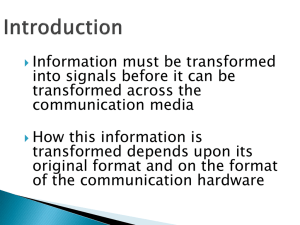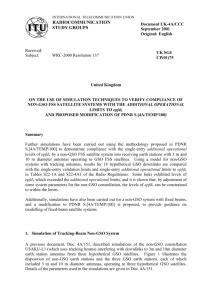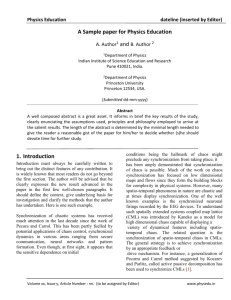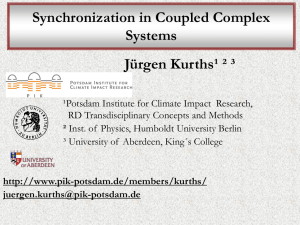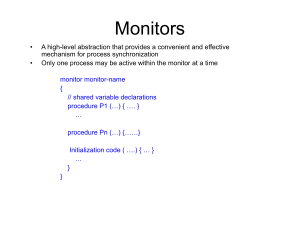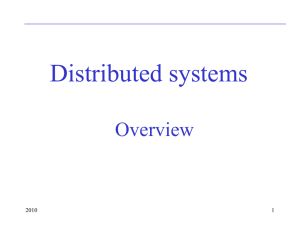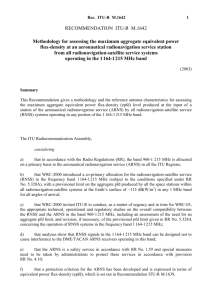Word - ITU
advertisement
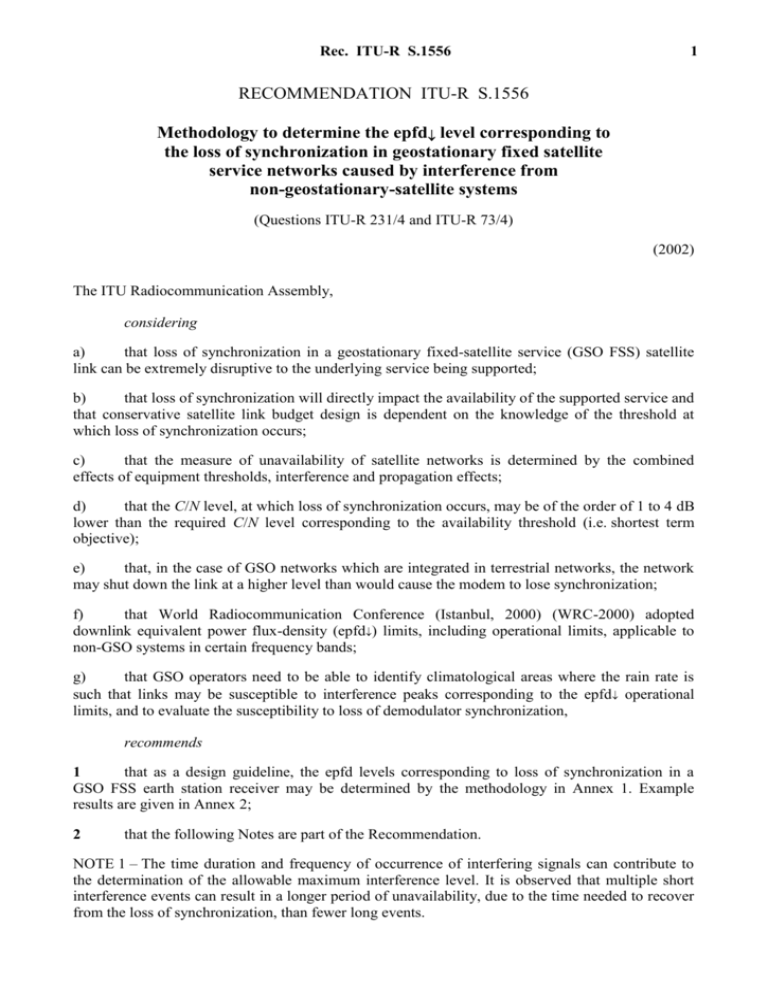
Rec. ITU-R S.1556 1 RECOMMENDATION ITU-R S.1556 Methodology to determine the epfd level corresponding to the loss of synchronization in geostationary fixed satellite service networks caused by interference from non-geostationary-satellite systems (Questions ITU-R 231/4 and ITU-R 73/4) (2002) The ITU Radiocommunication Assembly, considering a) that loss of synchronization in a geostationary fixed-satellite service (GSO FSS) satellite link can be extremely disruptive to the underlying service being supported; b) that loss of synchronization will directly impact the availability of the supported service and that conservative satellite link budget design is dependent on the knowledge of the threshold at which loss of synchronization occurs; c) that the measure of unavailability of satellite networks is determined by the combined effects of equipment thresholds, interference and propagation effects; d) that the C/N level, at which loss of synchronization occurs, may be of the order of 1 to 4 dB lower than the required C/N level corresponding to the availability threshold (i.e. shortest term objective); e) that, in the case of GSO networks which are integrated in terrestrial networks, the network may shut down the link at a higher level than would cause the modem to lose synchronization; f) that World Radiocommunication Conference (Istanbul, 2000) (WRC-2000) adopted downlink equivalent power flux-density (epfd) limits, including operational limits, applicable to non-GSO systems in certain frequency bands; g) that GSO operators need to be able to identify climatological areas where the rain rate is such that links may be susceptible to interference peaks corresponding to the epfd operational limits, and to evaluate the susceptibility to loss of demodulator synchronization, recommends 1 that as a design guideline, the epfd levels corresponding to loss of synchronization in a GSO FSS earth station receiver may be determined by the methodology in Annex 1. Example results are given in Annex 2; 2 that the following Notes are part of the Recommendation. NOTE 1 – The time duration and frequency of occurrence of interfering signals can contribute to the determination of the allowable maximum interference level. It is observed that multiple short interference events can result in a longer period of unavailability, due to the time needed to recover from the loss of synchronization, than fewer long events. 2 Rec. ITU-R S.1556 NOTE 2 – If there is unacceptable interference due to epfd levels which are not greater than the operational limits, the GSO network operator has the option of adjusting the link so that the interference is acceptable. NOTE 3 – In case of GSO FSS networks with lower data rates, the C/N level at which loss of synchronization occurs may be less than that of networks with higher data rates, while the time required for recovery of synchronization may be greater. Further study is needed to determine synchronization threshold levels for networks with data rates higher than 34 Mbit/s. NOTE 4 – Further study is needed to determine threshold levels for loss of synchronization in links that are integrated in terrestrial networks. ANNEX 1 This Annex provides a methodology that allows GSO operators to identify climatological areas that may have links that are susceptible to loss of synchronization at interference levels corresponding to the epfd operational limits. 1 Theoretical loss of synchronization epfd calculation Sensitivity to loss of synchronization due to rain is a global problem to GSO networks and non-GSO interference will increase the probability of loss of synchronization in all rain zones. Loss of synchronization can be extremely disruptive to certain services that, under current circumstances, are adequately provided over satellite networks. Since GSO networks are designed to reduce synchronization losses to near zero per cent of the time, the additional interference from non-GSO systems must also be taken into account. A simple I/N calculation can be performed to demonstrate whether or not a GSO earth station, receiving a given rain rate, is susceptible to epfd induced loss of synchronization (sync loss). The calculation depends on the received C/N: (C/N )sync loss C/(N I ), at which loss of synchronization occurs. (C/N)sync loss is typically in the range of 1 dB to about 4 dB below (C/N)required needed for the minimum BER performance objective desired for the link (i.e. the availability threshold). A link where (C/N ) ((C/N )required (C/N )sync loss) 1 dB is representative of 1/2 rate coding while (C/N ) = 3 dB is representative of 3/4 rate coding. Table 1 provides typical modulation and loss of synchronization information for systems with data rates less than 34 Mbits/s 1. ____________________ 1 This information, from Recommendation ITU-R S.1522, was used to calculate and evaluate the effects of epfd limits on GSO FSS networks operating in the 14/12 GHz band and whose availability is sensitive to synchronization timing recovery and interference emitted by non-GSO FSS networks. Rec. ITU-R S.1556 3 TABLE 1 Modulation and coding C/(N + I ) (dB) QPSK rate 7/8 6.0 QPSK rate 3/4 5.3 QPSK rate 1/2 3.5 8-PSK 8.1 16-QAM 11.0 QPSK: quadrature phase-shift keying 16-QAM: 16-quadrature amplitude modulation. Generally, the amount of C/N degradation to cause loss of synchronization is known (for a given link). Furthermore, the amount of margin needed to protect a network at a given rain rate in a specific frequency band can be estimated (see for example Table 2). This information can be used to calculate the interference levels that will cause a loss of synchronization for GSO links. For some sensitive links such levels may occur during some instances of the inline condition (i.e. GSO earth station, non-GSO satellite and GSO satellite are instantaneously in line). TABLE 2 Representative rain rate power compensation margins for the 12 GHz band Downlink availability Rain rates (%) (mm/h) 99.9 Downlink margin to counteract rate fade (dB) 99.99 5 10 15 20 25 30 35 40 45 50 55 60 0.4 0.8 1.3 1.6 1.9 2.3 2.6 2.9 3.2 3.4 3.7 3.9 1.3 2.9 4.1 5.2 6.2 7.1 7.9 8.8 9.5 10.2 10.9 11.6 NOTE 1 – Rain margin calculated per Recommendation ITU-R P.618 for 99.9% and 99.99% availability. Assuming altitude of all earth stations at 0.25 km, with vertical polarization at latitude of 40 and an elevation angle of 20. 4 Rec. ITU-R S.1556 The performance degradation of a communications link can be expressed in terms of an equivalent increase in the system noise temperature as compared to a link without the degrading influence. That relationship can be expressed as: Degradation 10 log((T TI ) / T ) dB It can also be shown that under clear sky conditions, for links designed such that the availability threshold margin is approximately equal to the rain margin, loss of synchronization will occur when: Degradation MR (C/N ) dB where: T: system noise temperature, includes noise from all known sources (K) TI : system noise temperature increase due to added interference source (K) MR : clear-sky downlink rain margin (dB) (C/N ) : decrease in threshold C/N from the lowest performance objective to the loss of synchronization level (dB). Accordingly then, under clear-sky conditions and for links designed such that the availability threshold margin is approximately equal to the rain margin, the relationship between the normal operating system noise temperature, the additional rain margin and the noise temperature increase due to interference which might cause loss of synchronization is given by equation (1) as follows: 10 log((T TI ) / T ) MR (C/N ) dB (1) The level of received interference power that would cause loss of synchronization can be determined by solving TI in equation (1). That resulting interference level allows the determination of the epfd level that would cause loss of synchronization. Accordingly, the noise temperature increase due to non-GSO interference that would cause sync loss is given in equation (2) as follows: TI (10(MR (C/N ))/10 1) T K (2) The increase in noise temperature, TI, due to non-GSO interference can then be used to calculate the resulting increase in received interference power, IT, with equation (3) as follows: IT 10 log (k TI B) dBW (3) where: B: 10 log k : reference bandwidth (40 Hz) 10 log (Boltzmann’s constant) 228.6 dB(W/(Hz K )). The epfd of a non-GSO interfering signal, IT, that will cause loss of synchronization if received on-axis can be determined from equation (3) by subtracting the equivalent antenna area as shown in equation (4): epfdsync loss IT – 10 log( D2/4) where: D: earth station antenna diameter : antenna efficiency. dB(W/(m2 40 kHz)) (4) Rec. ITU-R S.1556 5 ANNEX 2 This Annex gives some examples of the application of equations (2), (3) and (4) in Annex 1. Table 3 shows the combination of the earth station antenna sizes and system noise temperatures assumed in the application of this Recommendation. These combinations are realizable in some practical links. Figures 1 to 4 show epfd levels that would cause loss of synchronization in such GSO FSS links unless additional margin was provided. These values can be compared to the values in Table 22-4A of the Radio Regulations. TABLE 3 Earth station antenna sizes and system noise temperatures Earth station antenna diameter (m) System noise temperature (K) 3 350 4.5 450 6 600 10 800 FIGURE 1 3 m diameter earth station antenna epfd levels causing loss of synchronization epfd (dB(W/(m2 · 40 kHz))) –158 –159 –160 –161 –162 –163 5 10 15 20 25 30 35 40 45 50 55 60 Rain rate (mm/h) Availability = 99.99%; (C/N) = 1 dB Availability = 99.9%; (C/N) = 1 dB Availability = 99.99%; (C/N) = 3 dB Availability = 99.9%; (C/N) = 3 dB 1556-01 6 Rec. ITU-R S.1556 FIGURE 2 4.5 m diameter earth station antenna epfd levels causing loss of synchronization epfd (dB(W/(m2 · 40 kHz))) –160 –161 –162 –163 –164 5 10 15 20 25 30 35 40 45 50 55 60 Rain rate (mm/h) Availability = 99.99%; (C/N) = 1 dB Availability = 99.9%; (C/N) = 1 dB Availability = 99.99%; (C/N) = 3 dB Availability = 99.9%; (C/N) = 3 dB 1556-02 FIGURE 3 6 m diameter earth station antenna epfd levels causing loss of synchronization epfd (dB(W/(m2 · 40 kHz))) –162 –163 –164 –165 –166 5 10 15 20 25 30 35 40 45 50 55 60 Rain rate (mm/h) Availability = 99.99%; (C/N) = 1 dB Availability = 99.9%; (C/N) = 1 dB Availability = 99.99%; (C/N) = 3 dB Availability = 99.9%; (C/N) = 3 dB 1556-03 Rec. ITU-R S.1556 7 FIGURE 4 10 m diameter earth station antenna epfd levels causing loss of synchronization epfd (dB(W/(m2 · 40 kHz))) –163 –164 –165 –166 –167 –168 5 10 15 20 25 30 35 40 45 50 55 60 Rain rate (mm/h) Availability = 99.99%; (C/N) = 1 dB Availability = 99.9%; (C/N) = 1 dB Availability = 99.99%; (C/N) = 3 dB Availybility = 99.9%; (C/N) = 3 dB 1556-04



